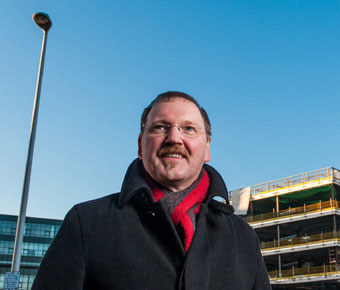
17 Nov 2014
We take the economic health of our city centre very seriously.
It has the largest concentration of business and jobs in Scotland and is Glasgow's front room to the visiting world - something which was patently obvious during the Commonwealth Games.
Last week ( October 9/10) the Chamber held a two day event that we named Tomorrow's City Centre (TCC), to dig deep into the technology trends that are shaping the future of the hearts of cities. We wanted to understand how digital technology is changing shopping behaviour, influencing how we entertain ourselves and shifting expectations of the office working place.
Back in 2011 we held our first conference devoted to the economic state of play of our city centre. Since then we've supported the City Council in the publication of a detailed City Centre Strategy and the creation of a City Centre Strategy Board, chaired by the Leader of the Council - to make sure the City Centre grows as Glasgow's primary location for wealth creation and jobs.
You can add to that activity Glasgow's success in attracting the Future Cities Demonstrator project, the Chamber's creation of both the City Centre Retail Association and the Sauchiehall Street Business Improvement District, and the City Council's achievement in securing a £1.13b City Deal. All of these developments are playing a part in the city centre's future.
At last week's TCC event we brought together thinkers from both the American and UK arms of the Urban Land Institute, the Government-backed and London-based Future Cities Catapult, University of Glasgow and the University of Strathclyde(Future Cities Demonstrator project). IBM, BT, John Lewis and a host of business people in Glasgow's retail, leisure and property worlds for whom the city centre is a critical part of their performance.
We will publish what we are calling our White Paper for Tomorrow's City Centre later in the year. I won't second guess the main priorities and projects that the Paper will contain, but I'll suggest some of the issues which the Paper will be tackling. Most of these are now becoming very familiar.
The impact of e-commerce on the role of shopping in town and city centres is the most obvious and there seems to be no doubt that the demand for retail space will continue to change with a lot of existing shop units failing to meet new expectations.
Shopping will not disappear from the city centre, and indeed many of the TCC delegates expected that there will be a much wider range of products and services available to buy. The importance of the shopping experience will grow not just because there is a growing demand for leisure eating and drinking to go alongside shops, but because shops will play a different role in a complicated buying journey.
Simon Russell from John Lewis and Danyn Bagge from IBM helped to draw out some examples - highlighting that more personalised shopping services, more effective targeting of product promotions and a big rise in Click and Collect are all already happening.
Our use of the internet is growing, but not always at the expense of the shop. Many well known brands might be reducing their need for space but the city centre is likely to see many more flagship stores where the shop is an entertainment, information and advice centre and not just a place to buy the product. Think Apple stores and you get the drift.
The quality of the shopping experience becomes ever more important and that means the experience of the city centre itself matters just as much. The public transport service, car access and parking, the look and feel of the city streets, safety and dealing with our weather; these will all be critical elements of a complete city centre experience. How these are managed needs careful co-ordination.
Workplaces and entertainment spaces will also go through change. We've seen some massive shifts in the demand for quality office space which has spurred on the International Financial Services District. But the downside has been the rise of vacant space in the upper floors of so many of our impressive Victorian buildings in the old Central Business District.
The Merchant City is an excellent example of a quality environment for night-time activity which flourished during the Games, but other parts of the city centre are arguably over-dominated by a younger market which in turn is changing habits and coming out much later at night. The BT and Urban Land Institute futurologists set down some of the new practices we can expect in these markets.
There are several themes that the White Paper will cover but one that hit home for me is the challenge of finding ways to make it easier to adapt office and retail space in older under-used buildings. It often takes far too long for the use of our buildings to change and vacant space damages perceptions of a centre's health and of its safety.
Can we learn from other cities in bringing space back into use for more living space - we have less than a quarter of the number of people living in Glasgow city centre than Manchester? Can we use space more flexibly and creatively to help smaller business with artisan products or community based social enterprises get established in and around the city centre?
The answer from cities like Melbourne and Newcastle in Australia seems to be yes. Dan Hill from the Future Cities Catapult was especially helpful in setting out some projects that could do that.
When we publish the White Paper we want to add to the successful delivery of the City Centre Strategy. The Strategy already sets out a detailed plan for the next three years. Our work is to help look even further ahead. Look out for the White Paper and let us know what you think.